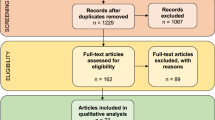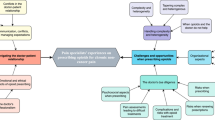Abstract
The controversial issue of prescribing opioids to people with spinal cord damage who have severe pain is discussed in this paper. The reasons for concern regarding the increase in opioid prescription over recent years are outlined, along with a summary of the major potential adverse outcomes associated with opioids, such as falls, respiratory suppression, adverse endocrine effects, cognitive impairment, and the potential for opioid abuse, addiction and death. Situations when opioids are more appropriate are considered to be in the immediate post-trauma or post-operative periods. More controversial is the use of opioids in chronic non-cancer pain. A brief review of the evidence regarding opioids in chronic non-cancer pain is presented, and strategies outlined for reducing the risk of adverse consequences from opioid use in chronic non-cancer pain. These strategies include considerations before starting opioids, during initiation, monitoring activities and the cessation process. A vital consideration before starting opioids includes ensuring that all alternatives to opioids have been fully considered and trialled. Finally, some pragmatic proposals for prescribing opioids in people with SCD are suggested. It is recommended that before opioids are commenced, that the informed consent process should be complimented by a treatment agreement, with an initial 4-week trial period, and close monitoring of established goals.
Similar content being viewed by others
Log in or create a free account to read this content
Gain free access to this article, as well as selected content from this journal and more on nature.com
or
Change history
04 February 2019
The original version of this article contained an error in the name of the author Peter Wayne New, which was incorrectly displayed. This has now been corrected in both the PDF and HTML versions of the article.
References
Kertesz SG, Manhapra A. The drive to taper opioids: mind the evidence, and the ethics. Spinal Cord Ser Cases. 2018.
Bryce TN. Opioids should not be prescribed for chronic pain after SCI. Spinal Cord Ser Cases. 2018.
President’s Council of Economic Advisors. The underestimated cost of the opioid crisis. Nov 2017. p. Available at https://www.whitehouse.gov/sites/whitehouse.gov/files/images/TheUnderestimated%Cost%of%the%Opioid%Crisis.pdf.
Centers for Disease Control. Drug overdose data, 2016, Available at https://www.cdc.gov/drugoverdose/data/statedeaths.html.
Carter JS. Opioid prescription crisis: Everyday Aussies, not ‘doctor shoppers’, at heart of crisis, experts say. 2017, Available at http://www.abc.net.au/news/2017-11-21/doctorshoppers-not-at-heart-of-prescription-opioid-crisis/9167606.
A province-by-province look at opioid-overdose stats, including fentanyl. Global News. 17 Nov 2016, Available at http://globalnews.ca/news/3072316/a-province-by-province-look-at-opioid-overdose-stats-including-fentanyl/. (accessed 2018 Apr. 7).
Freynhagen R, Geisslinger G, Schug SA. Opioids for chronic non-cancer pain. BMJ. 2013;346:f2937.
Chou R, Turner JA, Devine EB, Hansen RN, Sullivan SD, Blazina I, et al. The effectiveness and risks of long-term opioid therapy for chronic pain: a systematic review for a National Institutes of Health Pathways to Prevention workshop. Ann Intern Med. 2015;162:276–86.
Katz NP, Birnbaum HG, Castor A. Volume of prescription opioids used nonmedically in the United States. J Pain Palliat Care Pharmacother. 2010;24:141–4.
Kuehn BM. Opioid prescriptions soar: increase in legitimate use as well as abuse. JAMA. 2007;297:249–51.
Bryce TN, Budh CN, Cardenas DD, Dijkers M, Felix ER, Finnerup NB, et al. Pain after spinal cord injury: an evidence-based review for clinical practice and research: report of the National Institute on Disability and Rehabilitation Research Spinal Cord Injury Measures meeting. J Spinal Cord Med. 2007;30:421–40.
Hagen EM, Rekand T. Management of neuropathic pain associated with spinal cord injury. Pain Ther. 2015;41:51–65.
Dijkers M, Bryce T, Zanca J. Prevalence of chronic pain after traumatic spinal cord injury: a systematic review. J Rehabil Res Dev. 2009;46:13.
Nuesch E, Rutjes AW, Husni E, Welch V, Jüni P. Oral or transdermal opioids for osteoarthritis of the knee or hip. Cochrane Database Syst Rev. 2009;4:CD003115.
Manchikanti L, Ailinani H, Koyyalagunta D, Datta S, Singh V, Eriator I, et al. A systematic review of randomized trials of long-term opioid management for chronic non-cancer pain. Pain Physician. 2011;14:91–121.
Noble M, Treadwell JR, Tregear SJ, Coates VH, Wiffen PJ, Akafomo C, et al. Long-term opioid management for chronic noncancer pain. Cochrane Database Syst Rev. 2010;1:CD006605.
Finnerup NB, Sindrup SH, Jensen TS. The evidence for pharmacological treatment of neuropathic pain. Pain. 2010;150:573–81.
Hollingshead J, Dühmke RM, Cornblath DR. Tramadol for neuropathic pain. Cochrane Database Syst Rev. 2006;3:CD003726.
Eisenberg E, McNicol E, Carr DB. Opioids for neuropathic pain. Cochrane Database Syst Rev. 2006;3:CD006146.
Burke D, Fullen BM, Stokes D, Lennon O. Neuropathic pain prevalence following spinal cord injury: a systematic review and meta‐analysis. Eur J Pain. 2017;21:29–44.
Freynhagen R, Bennett MI. Diagnosis and management of neuropathic pain. BMJ. 2009;339:b3002.
National Institute for Health and Clinical Excellence. Neuropathic pain: the pharmacological management of neuropathic pain in adults in non-specialist settings. (Clinical guideline 173). 2018. Available at nice.org.uk/guidance/cg173 (accessed 2018, June 16th)
Guy SD, Mehta S, Casalino A, Côté I, Kras-Dupuis A, Moulin DE, et al. The CanPain SCI clinical practice guidelines for rehabilitation management of neuropathic pain after spinal cord: recommendations for treatment. Spinal Cord. 2016;54(Suppl 1):S14–23.
Grattan A, Sullivan MD, Saunders KW, Campbell CI, Von Korff MR. Depression and prescription opioid misuse among chronic opioid therapy recipients with no history of substance abuse. Ann Fam Med. 2012;10:304–11.
Chou R, Fanciullo GJ, Fine PG, Adler JA, Ballantyne JC, Davies P, et al. Clinical guidelines for the use of chronic opioid therapy in chronic noncancer pain. J Pain. 2009;10:113–30.
Dowell D, Haegerich TM, Chou R. CDC guideline for prescribing opioids for chronic pain—United States, 2016. JAMA. 2016;315:1624–45.
Busse JW, Craigie S, Juurlink DN, Buckley DN, Wang L, Couban RJ, et al. Guideline for opioid therapy and chronic noncancer pain. CMAJ. 2017;189:E659–E66.
Teasell RW, Mehta S, Aubut JA, Foulon B, Wolfe DL, Hsieh JT, et al. A systematic review of pharmacologic treatments of pain after spinal cord injury. Arch Phys Med Rehabil. 2010;91:816–31.
Mehta S, McIntyre A, Janzen S, Loh E, Teasell R, Spinal Cord Injury Rehabilitation Evidence Team. Systematic review of pharmacologic treatments of pain after spinal cord injury: an update. Arch Phys Med Rehabil. 2016;97:1381–91.
Fishman SM, Bandman TB, Edwards A, Borsook D. The opioid contract in the management of chronic pain. J Pain Symptom Manag. 1999;18:27–37.
Jacobson PL, Mann JD. The valid informed consent-treatment contract in chronic non-cancer pain: its role in reducing barriers to effective pain management. Comp Ther. 2004;30:101–4.
Hariharan J, Lamb GC, Neuner JM. Long-term opioid contract use for chronic pain management in primary care practice. A five year experience. J Gen Intern Med. 2007;22:485–90.
Cheatle MD, Savage SR. Informed consent in opioid therapy: a potential obligation and opportunity. J Pain Symptom Manag. 2012;44:105e16.
Tobin DG, Forte KK, McGee SJ. Breaking the pain contract: a better controlled-substance agreement for patients on chronic opioid therapy. Clev Clin J Med. 2016;83:827–35.
Rager JB, Schwartz PH. Defending opioid treatment agreements: disclosure, not promises. Hastings Cent Report. 2017;47:24–33.
Department of Health & Human Services. SafeScript: State Government Victoria; [cited 2018 19th April]. Available from: https://www2.health.vic.gov.au/public-health/drugs-and-poisons/safescript.
Author information
Authors and Affiliations
Corresponding author
Ethics declarations
Conflict of interest
The authors declare that they have no conflict of interest.
Rights and permissions
About this article
Cite this article
New, P.W. Severe chronic pain following spinal cord damage: a pragmatic perspective for prescribing opioids. Spinal Cord Ser Cases 4, 65 (2018). https://doi.org/10.1038/s41394-018-0094-3
Received:
Revised:
Accepted:
Published:
DOI: https://doi.org/10.1038/s41394-018-0094-3
This article is cited by
-
Survey on current treatments for pain after spinal cord damage
Spinal Cord Series and Cases (2019)



